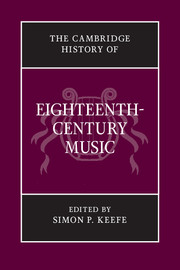Book contents
- Frontmatter
- PRELUDE
- PART I MUSIC FOR THE CHURCH
- 2 Catholic church music in Italy, and the Spanish and Portuguese Empires
- 3 Catholic sacred music in Austria
- 4 Catholic church music in France
- 5 Lutheran church music
- 6 Protestant church music in England and America
- INTERLUDE
- PART II MUSIC FOR THE THEATRE
- INTERLUDE
- PART III MUSIC FOR THE SALON AND CONCERT ROOM
- POSTLUDE
- Appendix I Chronology
- Appendix II Institutions in major European cities
- Appendix III Personalia
- Index
- References
3 - Catholic sacred music in Austria
from PART I - MUSIC FOR THE CHURCH
Published online by Cambridge University Press: 28 March 2011
- Frontmatter
- PRELUDE
- PART I MUSIC FOR THE CHURCH
- 2 Catholic church music in Italy, and the Spanish and Portuguese Empires
- 3 Catholic sacred music in Austria
- 4 Catholic church music in France
- 5 Lutheran church music
- 6 Protestant church music in England and America
- INTERLUDE
- PART II MUSIC FOR THE THEATRE
- INTERLUDE
- PART III MUSIC FOR THE SALON AND CONCERT ROOM
- POSTLUDE
- Appendix I Chronology
- Appendix II Institutions in major European cities
- Appendix III Personalia
- Index
- References
Summary
Some idea of the centrality of religious music in eighteenth-century life in Austria and southern Germany can be garnered from the following passage from Charles Burney’s description of his visit to Vienna in 1772:
there is scarce a church or convent in Vienna, which has not every morning its mass in music: that is, a great portion of the church service of the day, set in parts, and performed with voices, accompanied by at least three or four violins, a tenor and base, besides the organ, and as the churches here are daily crowded, this music, though not of the most exquisite kind, must in some degree form the ear of the inhabitants.
Undoubtedly a principal reason for this prevalence of musica da chiesa was the intimate association of the Roman Catholic faith with the political rule of the Holy Roman Emperors, whose cultural and ideological imprint radiated outwards from the Austrian capital to far-flung territories of the Empire as well as to lands with close ties to Vienna, such as Salzburg, Bavaria and Saxony. Therefore the concept of an ‘imperial style’ (Reichstil) broadly characterizes the subject matter of the present chapter, though it is not intended to deny the regional and institutional diversity of sacred music practices and repertories.
- Type
- Chapter
- Information
- The Cambridge History of Eighteenth-Century Music , pp. 59 - 112Publisher: Cambridge University PressPrint publication year: 2009
References
- 2
- Cited by



